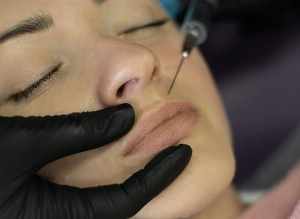Botulinum toxin (Botox®): How can it be used to treat certain chronic health conditions?
Published Jan 27, 2022 • By Candice Salomé
Widely known for its cosmetic use, botulinum toxin (Botox®) is a purified neurotoxin produced by the bacterium Clostridium botulinum, that can paralyze muscles. But its properties are also used to relieve the symptoms of certain diseases.
How does Botox® work? Which conditions can it treat? What does the research say?
We explain it all in our article!

We all know that Botox® is used to reduce the appearance of wrinkles, but it is also used to treat certain conditions. By blocking neuromuscular transmission, botulinum toxin helps the muscle relax and makes it possible to alleviate or even stop a large number of disabling symptoms.
What is Botox® and how does it work?
Botox® is the commercial name for botulinum toxin. It is produced by the bacterium Clostridium botulinum and is able to inhibit neuromuscular transmission, thus preventing muscle contraction.
Expression wrinkles (also called "dynamic wrinkles"), for example, form due to the repeated contractions of certain muscles: "crow's feet" at the outer corners of the eyes or "frown lines" between the eyebrows.
Botulinum toxin can neutralize the muscles responsible for the formation of wrinkles. The skin then no longer suffers from the mechanical impact caused by muscle contraction.
It was in the early 1950s that the American Vernon Brooks discovered the effects of botulinum toxin on involuntary muscle contractions. However, it was not until 1980 that an American ophthalmologist used Botox® for the first time, to treat strabismus.
Since then, therapeutic indications for Botox® have continued to multiply. Apart from aesthetic medicine, this molecule is also used in urology to treat incontinence and in dermatology to combat excessive sweating.
Which health conditions can be treated by Botox®?
Hyperhidrosis
Botulinum toxin injections as a treatment for hyperhidrosis, or excessive sweating, are only considered as a last resort. They are performed by a dermatologist.
After specific tests highlighting the zones affected by excessive sweating, the dermatologist injects botulinum toxin at different sites. The injections stop the production of sweat by interrupting the signal transmitted to the sweat glands by the brain.
Generally, the effect from the injections lasts for a period of 3 to 6 months. Further courses should be scheduled every 6 months. The injections should be spaced out by at least 3 months.
Urinary incontinence
Urinary incontinence is a common disorder. People with overactive bladder suffer from involuntary bladder contractions, or spasms, which cause an urgent and irrepressible need to urinate. These urges often result in involuntary loss of urine.
Botulinum toxin injections are performed by a urologist directly into the bladder area. Due to the paralyzing effect of the Botox®, the bladder muscles relax.
The bladder is then able to retain a greater quantity of urine and involuntary contractions of the bladder muscle are reduced.
Botulinum toxin also acts on the sensory nerves, reducing the sensation of urgency.
The results obtained with botulinum toxin show that it can reduce or even eliminate bladder weakness.
Botox® injections are, however, resorbable. A new injection is required every 6 to 9 months.
Neuropathic pain
Botulinum toxin injections may also be effective in reducing neuropathic pain, according to the results of a study published in the medical journal The Lancet.
Neuropathic pain is often related to nerve damage after, for example, surgery, trauma or due to neurological disease.
Researchers conducted a three-center study in which they compared the effect of two subcutaneous injections, a placebo and botulinum toxin, on neuropathic pain.
The injections were carried out at 3-month intervals on patients who were continuing their usual treatment at the same time.
After 24 weeks of follow-up, the researchers assessed the patients' pain on a scale from 0 to 10. On average, patients who received botulinum toxin injections felt their pain reduce from 6.5 to 4.6, compared to 6.4 to 5.8 for patients who received the placebo.
In addition, patients who had a significant response to the first injection were more relieved after the second injection.
Thus, the results of this clinical trial provide real hope for people suffering from neuropathic pain. In fact, repeated injections of botulinum toxin seem to be effective in combating this type of pain, which is often only partially relieved by conventional treatments.
Bruxism
Botox® is also a solution for bruxism, a very common condition. Bruxism is the involuntary clenching of the jaws, which causes pain. Botulinum toxin is used to treat this pain.
The doses of the injections are adapted to each patient. The otolaryngologist performs 3 injections on each side of the face. He or she uses electromyography to inject the Botox® into the right muscle. The botulinum toxin takes effect a few days after the injections with a maximum effect obtained within 2 or more weeks.
In most cases, the injections need to be repeated every 4 to 6 months.
Migraines
As the trend to reduce the appearance of wrinkles with the help of Botox® took off in the late 1990s, doctors and beauticians who performed the injections were hearing from their patients that they were less prone to migraines after the injections.
Researchers quickly began to take a special interest in the pain-relieving property of botulinum toxin.
The use of Botulinum toxin type A injections to treat chronic migraines was approved in 2010. To get this type of treatment the patient must be an adult suffering from chronic migraine headaches, which means that he or she has a history of migraine headaches and has headaches for 15 or more days of the month. The course of treatment can be repeated every 12 weeks, to reduce or prevent migraines.
Share your thoughts and questions with the community in the comments below!
Take care!
Sources:
Botox : nouveau remède contre l’incontinence par impériosité, Hartmann
Hypersudation (transpiration excessive) : quel traitement ?, Ameli
Soulager les douleurs neuropathiques grâce au Botox, INSERM
Soigner grâce à la toxine botulique, Allo Docteurs
BOTOX 50 - 100 - 200 mg (toxine botulinique type A) (migraine chronique), HAS
Migraine chronique : moins de crises grâce à la toxine botulique, Migraine.fr
Botox injections for migraine treatment, webmd.com
1 comment
You will also like

What are the dangers associated with the over-the-counter sale of certain medicines?
Dec 19, 2020 • 6 comments

 Facebook
Facebook Twitter
Twitter


